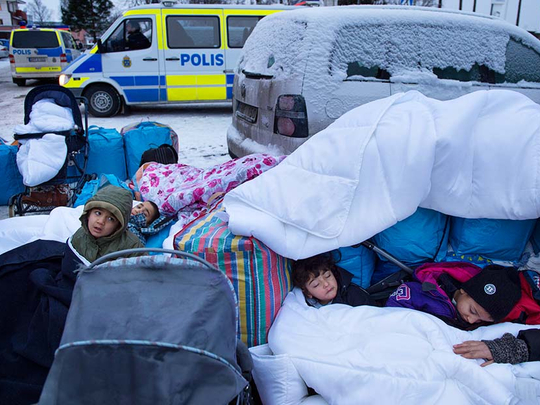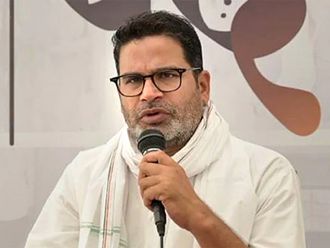
I fell in love with my wife and her native Sweden at the same time, and with almost equal force. For 15 years I’ve been arguing about the country’s virtues with room-emptying enthusiasm. From schools to childcare to pensions, Sweden has just seemed more advanced than us.
A visit to Stockholm has always seemed like a trip to the future — a glimpse of how things might look in Britain, in a decade or two, if all goes well. But right now, Sweden is sending another message: how quickly crisis can engulf even a strong country if it gets immigration wrong.
This week’s news — that it intends to deport up to 80,000 failed asylum seekers — certainly sounds tough. But in Sweden, the announcement was greeted with derision. A pattern has now been established: when asylum seekers have their case rejected, most disappear. They have no address, no papers and find it fairly easy to give Swedish authorities the slip.
On average, seven out of 10 of those facing deportation just vanish. Or, rather, they stay in the country and keep gaming a system that could have been designed for ease of exploitation. No wonder the public scoff.
Perhaps the hardest problem facing Sweden, though, is the same one confronting David Cameron: what to do about unaccompanied children? They are an increasing part of the Great Migration, some separated from their parents under awful circumstances, some orphaned by war. The argument for accepting them is as powerful as it is simple: adults might be asked to fend for themselves elsewhere, but what kind of government would turn back a child?
This is the case being made by Save the Children, which has an influential ambassador in the form of Samantha Cameron. For years, Sweden was tremendously successful in integrating young newcomers; in 2004, it was absorbing about 400 children a year. Five years ago, this had grown to 2,600 — and even then, the system was starting to creak. But this was as nothing, compared to what was to come.
Last year, 35,000 unaccompanied children claimed asylum in Sweden — most of whom had arrived in the last four months of 2015. The number is hard for Brits — for anyone — to comprehend. They ask for food, accommodation and the kind of care to which every child is entitled — but providing the right care to so many is a task that would overwhelm a superpower, let alone a small Nordic state.
Care homes have been set up so quickly that they fall far short of what’s needed to protect the staff, let alone the children. On Monday, a 22-year-old working at one of the homes — herself the daughter of immigrants — was stabbed to death. A 15-year-old refugee is being held.
The vast majority of children are peaceful, scared and desperate to start a new life. They are the type that Save the Children talks about. But, as Sweden has found, there are many kinds of child refugees. There are fake children, who lie about their age to have a better chance of asylum. There are “anchor children”, who are sent ahead by their desperate family. There are also trafficked children, who may still be in the hands of gangmasters and are being forced into work or prostitution. And there are the “street children” who live in abandoned buildings and are often sucked into a criminal underworld.
In Gothenburg recently, 18 boys were found in an abandoned house with no toilets and no heating; the temperature was well below zero. They were sleeping on the floor, many under the same quilt to keep warm — one was just nine years old. But after being placed in a care home, they ran away and ended up sleeping rough again. The police suspect the very act of caring turned them away. As one officer put it: “They are not used to anyone being nice to them; it’s hard to understand what they have been through.”
Such children need and deserve a lot of care, which the government just cannot provide. There are hundreds of these street children in Sweden; police estimate at least 200 live in Stockholm, supporting themselves through crime. If caught stealing, they can say they’re under-16, in which case the police are almost certain to let them go. This isn’t the result of war: most are from Morocco and other parts of North Africa where “street children” have long been a problem.
But in the era of the Great Migration, even homeless children are on the move. While many children are fleeing war, most are seeking a better life — a basic, noble and incredibly powerful human instinct. And as word got out that warm-hearted Sweden accommodates anyone who claims to be under-18, they started to come in their thousands.
Cameron is offering to take 20,000 Syrian refugees — young and old — over the next five years. This is the same number that was arriving in Sweden every two weeks, until they finally brought back border controls. Sweden is desperate: it wants a new system whereby the EU will distribute refugees to countries deemed able to take them. And it wants Britain to join in: our fair share has been calculated at about 90,000 a year. As one minister told me recently: “We didn’t invade Iraq: Britain did.”
It’s a point the Swedish government would never make in public, but it shows the strength of feeling. Their anger is understandable. Would so many Afghans be arriving in Sweden if Tony Blair had lived up to his promise of building a better government in Afghanistan? Would migrants be flooding through Libya if Britain hadn’t helped depose its government and usher in chaos?
This is why Cameron can expect far more pressure to take extra refugees from Europe, especially if Britain votes to stay in the EU and loses its leverage. He should stand firm. We may be a country with a jobs boom and a strong record of social cohesion, but we’re a country where some 8,000 families are already needed to look after vulnerable children. How many more Britons can we realistically expect to care for unaccompanied refugees?
Cameron’s main policy — an unrivalled £1 billion (Dh5.25 billion) to care for refugees near Syria — is compassionate and hard-headed. The combination is vital, as the lesson from the Continent is clear: to let in more immigrants than you can handle leads to trouble, but to admit more children than you can care for leads to tragedy.
Fraser Nelson is editor of The Spectator.










